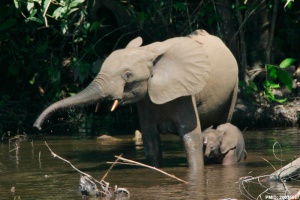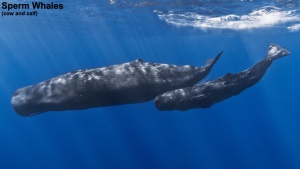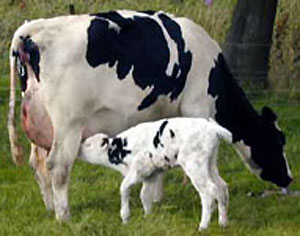K12 Animal Development Times: Difference between revisions
From Embryology
mNo edit summary |
mNo edit summary |
||
| (17 intermediate revisions by the same user not shown) | |||
| Line 1: | Line 1: | ||
==About Development Times== | ==About Development Times== | ||
[[File:African_elephant_cow_and_calf.jpg|thumb|300px|African elephant cow and calf]] | [[File:African_elephant_cow_and_calf.jpg|thumb|300px|link=Elephant Development|alt=African elephant cow and calf|African elephant cow and calf]] | ||
[[File:Sperm whales.jpg|thumb|300px|Sperm whale cow and calf]] | [[File:Sperm whales.jpg|thumb|300px|Sperm whale cow and calf]] | ||
[[File:Dog-adult.jpg|thumb|300px|link=Dog Development|alt=Dog|Dog]] | |||
[[File:Cowcalf.jpg|thumb|300px|Cattle cow and calf]] | [[File:Cowcalf.jpg|thumb|300px|Cattle cow and calf]] | ||
[[File:Opossum and pups.jpg|thumb|300px|Opossum and pups]] | [[File:Opossum and pups.jpg|thumb|300px|Opossum and pups]] | ||
The number of days development before birth or hatching in the table below | The number of days development before birth or hatching in the table below are the typical days value, some individual animals may be shorter or longer by different number of days. Note also that reptile and bird incubation times are affected by the environmental temperature, colder is generally longer. | ||
| Line 16: | Line 17: | ||
* This table can be sorted by either the animal name or by the days development (by clicking the triangles in the column headings). | * This table can be sorted by either the animal name or by the days development (by clicking the triangles in the column headings). | ||
* This content is only designed for K12 students to make them think about comparative development and does not cover other developmental topics. | * This content is only designed for K12 students to make them think about comparative development and does not cover other developmental topics. | ||
* More detailed animal information can be found on the [[Animal Development]] pages. | * More detailed animal information can be found by clicking on the animal pictures on this page. | ||
Research Questions not answered on this page | * Detailed information, not designed for K12, can be found on the lefthand menu [[Animal Development|Animals]] pages. | ||
* | |||
* | '''Additional Research Questions''' (not answered on this page) | ||
* How many young each animal species can give birth to at once? | |||
* Which newborn animals are fed milk (mammals) by their mothers? | |||
|} | |} | ||
| Line 28: | Line 31: | ||
# Which animals live in our homes or on a farm (domestic)? | # Which animals live in our homes or on a farm (domestic)? | ||
# Which animals live in the wild or seen in zoos? | # Which animals live in the wild or seen in zoos? | ||
{| class="wikitable sortable" border="1" | {| class="wikitable sortable" border="1" | ||
|+ Animal Development Time | |+ [[Animal_Development|Animal Development Time]] | ||
|- | |- | ||
! scope="col" | ! scope="col" | Animal | ||
! scope="col" | ! scope="col" | Average Days | ||
|- | |- | ||
| Bear (Black) | | Bear (Black) | ||
| Line 65: | Line 69: | ||
| 63 | | 63 | ||
|- | |- | ||
| Deer (Mule) | | [[Book_-_Normal_Plates_of_the_Development_of_Vertebrates_6|Deer]] (Mule) | ||
| 200 | | 200 | ||
|- | |- | ||
| Line 223: | Line 227: | ||
| Tapir | | Tapir | ||
| 390 | | 390 | ||
|- | |||
| [[Book_-_Normal_Plates_of_the_Development_of_Vertebrates_7|Tarsier]] | |||
| 182 | |||
|- | |- | ||
| Tiger | | Tiger | ||
| Line 245: | Line 252: | ||
{| | |||
{| | |||
|- | |- | ||
! Animal Notes and Table Data Sources | ! Animal Notes and Table Data Sources | ||
| Line 254: | Line 259: | ||
'''Notes''' | '''Notes''' | ||
* Each animal species has different variations +/- the average values shown in the table. | * Each animal species has different variations +/- the average values shown in the table. | ||
* Gestation is the carrying of an animal embryo or fetus inside a female animal | * Gestation is the carrying of an animal embryo or fetus inside a female animal. | ||
* Incubation is the laying of an egg (birds, reptiles, | * Incubation is the laying of an egg (birds, reptiles, monotremes) with development occurring outside the female animal. | ||
{{Animals}} | {{Animals}} | ||
| Line 265: | Line 270: | ||
* Witschi, E. (1962) Development: Rat. In: Growth Including Reproduction and Morphological Development. Altman, P. L. , and D. S. Dittmer, ed. Fed. Am. Soc. Exp. Biol., Washington DC, pp. 304-314. | * Witschi, E. (1962) Development: Rat. In: Growth Including Reproduction and Morphological Development. Altman, P. L. , and D. S. Dittmer, ed. Fed. Am. Soc. Exp. Biol., Washington DC, pp. 304-314. | ||
|} | |} | ||
{{Animal development period table}} | |||
'''Animal Notes''' | |||
* Each animal species has different variations +/- the average values shown in the table. | |||
* Gestation is the carrying of an animal embryo or fetus inside a female animal giving live birth. | |||
* Incubation is the laying of an egg (birds, reptiles, platypus, echidna) with development occurring outside the female animal. | |||
{{Animals}} | |||
{{Footer}} | {{Footer}} | ||
[[Category:K12]] | [[Category:K12]] | ||
Latest revision as of 09:52, 27 October 2014
About Development Times
The number of days development before birth or hatching in the table below are the typical days value, some individual animals may be shorter or longer by different number of days. Note also that reptile and bird incubation times are affected by the environmental temperature, colder is generally longer.
| For the Teacher |
|---|

Additional Research Questions (not answered on this page)
|
Questions
- Which animals have the shortest and longest development times?
- Which is the biggest animal?
- Which is the smallest animal?
- Which animals live in our homes or on a farm (domestic)?
- Which animals live in the wild or seen in zoos?
| Animal | Average Days |
|---|---|
| Bear (Black) | 210 |
| Bison | 270 |
| Budgerigar | 18 |
| Camel | 410 |
| Cat | 65 |
| Cattle | 281 |
| Chicken | 21 |
| Chimpanzee | 236 |
| Chinchilla | 111 |
| Coyote | 63 |
| Deer (Mule) | 200 |
| Dog | 63 |
| Donkey | 365 |
| Duck | 28 |
| Duck (Muscovy) | 35 |
| Elephant | 660 |
| Elk, Wapiti | 255 |
| Ferret | 42 |
| Finch | 14 |
| Fox | 52 |
| Giraffe | 425 |
| Goat | 150 |
| Goose | 28 |
| Gorilla | 270 |
| Guinea fowl | 28 |
| Guinea pig | 68 |
| Hare | 36 |
| Hippopotamus | 240 |
| Horse | 338 |
| Human | 274 |
| Leopard | 95 |
| Lion | 108 |
| Llama | 350 |
| Marmoset | 150 |
| Mink (European) | 41 |
| Monkey (Macaque) | 180 |
| Moose | 240 |
| Mouse | 20 |
| Muskox | 255 |
| Muskrat | 29 |
| Nutria, Coypu | 130 |
| Opossum | 12 |
| Otter | 285 |
| Panther | 90 |
| Parrot | 26 |
| Pheasant | 24 |
| Pig | 114 |
| Pigeon | 18 |
| Porcupine | 210 |
| Pronghorn | 230 |
| Quail | 16 |
| Rabbit | 31 |
| Raccoon | 63 |
| Rat | 21 |
| Reindeer | 225 |
| Rhinoceros (African) | 480 |
| Seal | 330 |
| Sheep | 150 |
| Shrew | 20 |
| Skunk | 63 |
| Squirrel (Gray) | 40 |
| Swan | 35 |
| Tapir | 390 |
| Tarsier | 182 |
| Tiger | 103 |
| Turkey | 28 |
| Walrus | 450 |
| Whale (Sperm) | 450 |
| Wolf | 63 |
| Woodchuck | 31 |
| Animal Notes and Table Data Sources | ||
|---|---|---|
|
Notes
Data Sources
|
| Animal Development Time | ||||||||||||||||||||||||||||||||||||||||||||||||||||||||||||||||||||||||||||||||||||||||||||||||||||||||||||||||||||||||||||||||||||||||||||||
|---|---|---|---|---|---|---|---|---|---|---|---|---|---|---|---|---|---|---|---|---|---|---|---|---|---|---|---|---|---|---|---|---|---|---|---|---|---|---|---|---|---|---|---|---|---|---|---|---|---|---|---|---|---|---|---|---|---|---|---|---|---|---|---|---|---|---|---|---|---|---|---|---|---|---|---|---|---|---|---|---|---|---|---|---|---|---|---|---|---|---|---|---|---|---|---|---|---|---|---|---|---|---|---|---|---|---|---|---|---|---|---|---|---|---|---|---|---|---|---|---|---|---|---|---|---|---|---|---|---|---|---|---|---|---|---|---|---|---|---|---|---|---|
| ||||||||||||||||||||||||||||||||||||||||||||||||||||||||||||||||||||||||||||||||||||||||||||||||||||||||||||||||||||||||||||||||||||||||||||||
Animal Notes and Table Data Sources
|
Animal Notes
- Each animal species has different variations +/- the average values shown in the table.
- Gestation is the carrying of an animal embryo or fetus inside a female animal giving live birth.
- Incubation is the laying of an egg (birds, reptiles, platypus, echidna) with development occurring outside the female animal.
| Animal Development: axolotl | bat | cat | chicken | cow | dog | dolphin | echidna | fly | frog | goat | grasshopper | guinea pig | hamster | horse | kangaroo | koala | lizard | medaka | mouse | opossum | pig | platypus | rabbit | rat | salamander | sea squirt | sea urchin | sheep | worm | zebrafish | life cycles | development timetable | development models | K12 |
Cite this page: Hill, M.A. (2024, June 3) Embryology K12 Animal Development Times. Retrieved from https://embryology.med.unsw.edu.au/embryology/index.php/K12_Animal_Development_Times
- © Dr Mark Hill 2024, UNSW Embryology ISBN: 978 0 7334 2609 4 - UNSW CRICOS Provider Code No. 00098G




